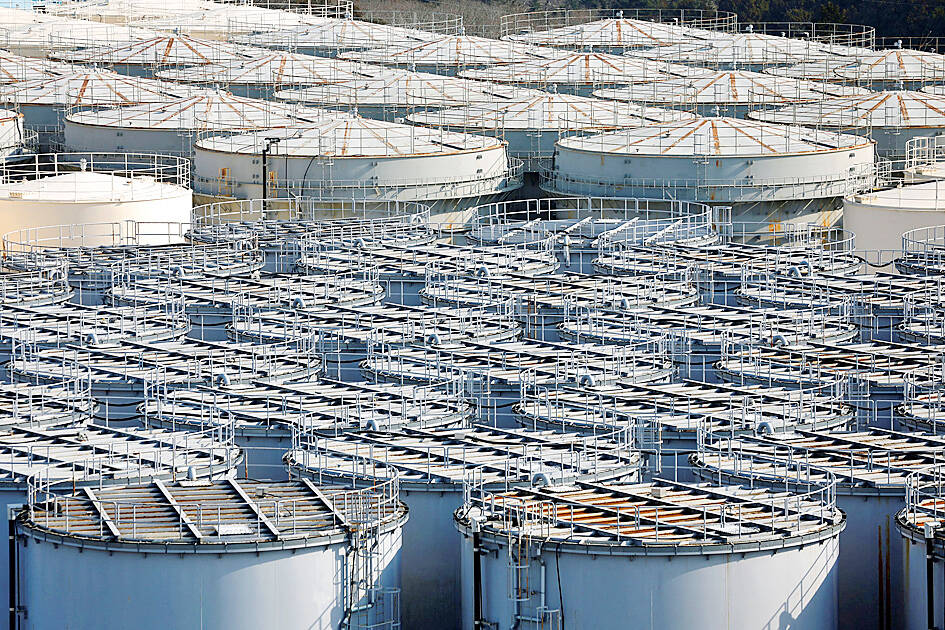Japan yesterday passed a law allowing nuclear reactors to operate beyond 60 years, as it tries to reinvigorate the sector to meet energy challenges and climate targets.
The bill intends to “establish an electricity supply system that will achieve a carbon-free society,” a parliament spokesman said.
Under the new rules, the age cap technically remains 60 years, but exceptions would be allowed for reactors that have had to pause operations for “unforeseeable” reasons.

Photo: Reuters
Those might include changes to safety guidelines or provisional injunctions by a court.
The new rules would allow operators to exclude periods of shutdown when calculating the total years of operation.
However, operators would require approval from Japan’s nuclear safety watchdog for the exemption, and the law also includes measures intended to strengthen safety checks at aging reactors.
The government wants to “ensure a stable supply of electricity while promoting the use of carbon-free electricity resources,” the Japanese Ministry of Economy, Trade and Industry wrote in a statement.
The move comes as the Japanese government looks to reinvigorate a nuclear sector that was taken offline after the 2011 Fukushima Dai-ichi nuclear power plant disaster caused by a deadly tsunami.
Most of Japan’s nuclear reactors remain out of action today, but the global energy crisis has reopened debate on the subject, and polls show that public views on nuclear power are softening.

Seven people sustained mostly minor injuries in an airplane fire in South Korea, authorities said yesterday, with local media suggesting the blaze might have been caused by a portable battery stored in the overhead bin. The Air Busan plane, an Airbus A321, was set to fly to Hong Kong from Gimhae International Airport in southeastern Busan, but caught fire in the rear section on Tuesday night, the South Korean Ministry of Land, Infrastructure and Transport said. A total of 169 passengers and seven flight attendants and staff were evacuated down inflatable slides, it said. Authorities initially reported three injuries, but revised the number

‘BALD-FACED LIE’: The woman is accused of administering non-prescribed drugs to the one-year-old and filmed the toddler’s distress to solicit donations online A social media influencer accused of filming the torture of her baby to gain money allegedly manufactured symptoms causing the toddler to have brain surgery, a magistrate has heard. The 34-year-old Queensland woman is charged with torturing an infant and posting videos of the little girl online to build a social media following and solicit donations. A decision on her bail application in a Brisbane court was yesterday postponed after the magistrate opted to take more time before making a decision in an effort “not to be overwhelmed” by the nature of allegations “so offensive to right-thinking people.” The Sunshine Coast woman —

BORDER SERVICES: With the US-funded International Rescue Committee telling clinics to shut by tomorrow, Burmese refugees face sudden discharge from Thai hospitals Healthcare centers serving tens of thousands of refugees on the Thai-Myanmar border have been ordered shut after US President Donald Trump froze most foreign aid last week, forcing Thai officials to transport the sickest patients to other facilities. The International Rescue Committee (IRC), which funds the clinics with US support, told the facilities to shut by tomorrow, a local official and two camp committee members said. The IRC did not respond to a request for comment. Trump last week paused development assistance from the US Agency for International Development for 90 days to assess compatibility with his “America First” policy. The freeze has thrown
TESTING BAN: Satellite photos show a facility in the Chinese city of Mianyang that could aid nuclear weapons design and power generation, a US researcher said China appears to be building a large laser-ignited fusion research center in the southwestern city of Mianyang, experts at two analytical organizations said, a development that could aid nuclear weapons design and work exploring power generation. Satellite photos show four outlying “arms” that would house laser bays, and a central experiment bay that would hold a target chamber containing hydrogen isotopes the powerful lasers would fuse together, producing energy, said Decker Eveleth, a researcher at US-based independent research organization CNA Corp. It is a similar layout to the US$3.5 billion US National Ignition Facility (NIF) in northern California, which in 2022 generated